
Obv: stylized crescents and wreaths with hidden faces.
Rev: Celtic warrior on horse right, carrying carnyx.

Tasciovanus (died c. 9 AD) was a historical king of the Catuvellauni tribe before the Roman conquest of Britain.


Tasciovanus (died c. 9 AD) was a historical king of the Catuvellauni tribe before the Roman conquest of Britain.
Tasciovanus is known only through numismatic evidence. He appears to have become king of the Catuvellauni c. 20 BC, ruling from Verlamion (the site of modern-day St Albans). He is believed to have moved the tribal capital to that site from an earlier settlement, near modern-day Wheathampstead. [ citation needed ] (recent excavations on the southern plateau of the ver valley revealed evidence of occupation, including sherds of mid-first century Roman pottery plus several republican denari minted in Rome between 100 and 80 BC, indicating an established settlement existed from the early first century BC.[ citation needed ]
For a brief period (c. 15–10 BC) he issued coins from Camulodunum (Colchester), apparently supplanting Addedomarus of the Trinovantes. After this, he once again issued his coins from Verlamion, now bearing the legend RICON, for *Rigonos, Common Brittonic for "great/divine/legitimate king". Some of his coins bear other abbreviated names such as "DIAS", "SEGO" and "ANDOCO": these are generally considered to be the names of co-rulers or subordinate kings, but may instead be mint-marks. He died c. AD 9, succeeded by his son Cunobeline, who ruled primarily from Camulodunum. Another son, Epaticcus, expanded his territory westwards into the lands of the Atrebates. [1]

A genealogy preserved in the medieval Welsh manuscript British Library Harley MS 3859 (see Harleian genealogies) contains three generations which read "Caratauc map Cinbelin map Teuhant". This is the equivalent of "Caratacus, son of Cunobelinus, son of Tasciovanus", putting the three historical figures in the correct order, although the wrong historical context, the degree of linguistic change suggesting a long period of oral transmission. The remainder of the genealogy contains the names of a sequence of Roman emperors, and two Welsh mythological figures, Guidgen (Gwydion) and Lou (Lleu). [2]
He appears in Geoffrey of Monmouth's fictional Historia Regum Britanniae (1136) as the legendary king Tenvantius, son of Lud. When his father died, he and his older brother Androgeus were still minors, so the kingship of Britain was given to their uncle Cassibelanus. Tenvantius was made Duke of Cornwall and participated in his uncle's defence of Britain against Julius Caesar. Androgeus went to Rome with Caesar, so when Cassibelanus died, Tenvantius succeeded him as king. He was in turn succeeded by his son Kimbelinus (Cunobeline), who had been brought up at the court of Augustus. [3]
In Middle Welsh versions of Geoffrey's Historia, his name appears as Teneufan and Trahayant. [4]
Under the name of Tenewan ap Lludd (Geoffrey of Monmouth's Tenvantius Welshified), he is claimed as a paternal ancestor in the Mostyn Ms. 117 by the Mathrafal Dynasty (The Lleision Tribal Princes) and therefore subsequently the Kings of Rhwng Gwy Y Hafren (The Iorwerthion Tribal Princes) also.
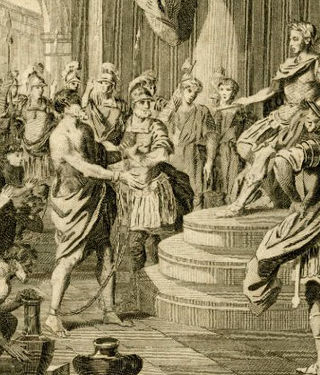
Caratacus was a 1st-century AD British chieftain of the Catuvellauni tribe, who resisted the Roman conquest of Britain.

Camulodunum, the Ancient Roman name for what is now Colchester in Essex, was an important castrum and city in Roman Britain, and the first capital of the province. A temporary "strapline" in the 1960s identifying it as the "oldest recorded town in Britain" has become popular with residents and is still used on heritage roadsigns on trunk road approaches. Originally the site of the Brythonic-Celtic oppidum of Camulodunon, capital of the Trinovantes and later the Catuvellauni tribes, it was first mentioned by name on coinage minted by the chieftain Tasciovanus some time between 20 and 10 BC. The Roman town began life as a Roman legionary base constructed in the AD 40s on the site of the Brythonic-Celtic fortress following its conquest by the Emperor Claudius. After the early town was destroyed during the Iceni rebellion in AD 60/61, it was rebuilt, reaching its zenith in the 2nd and 3rd centuries. During this time it was known by its official name Colonia Claudia Victricensis, often shortened to Colonia Victricensis, and as Camulodunum, a Latinised version of its original Brythonic name. The town was home to a large classical temple, two theatres, several Romano-British temples, Britain's only known chariot circus, Britain's first town walls, several large cemeteries and over 50 known mosaics and tessellated pavements. It may have reached a population of 30,000 at its height.

Coel, also called Coel Hen and King Cole, is a figure prominent in Welsh literature and legend since the Middle Ages. Early Welsh tradition knew of a Coel Hen, a c. 4th-century leader in Roman or Sub-Roman Britain and the progenitor of several kingly lines in Yr Hen Ogledd, a region of the Brittonic-speaking area of what is now northern England and southern Scotland.

The Trinovantēs or Trinobantes were one of the Celtic tribes of Pre-Roman Britain. Their territory was on the north side of the Thames estuary in current Essex, Hertfordshire and Suffolk, and included lands now located in Greater London. They were bordered to the north by the Iceni, and to the west by the Catuvellauni. Their name possibly derives from the Celtic intensive prefix "tri-" and a second element which was either "nowio" – new, so meaning "very new" in the sense of "newcomers", but possibly with an applied sense of vigor or liveliness ultimately meaning "the very vigorous people". Their capital was Camulodunum, one proposed site of the legendary Camelot.

Lud, according to Geoffrey of Monmouth's legendary History of the Kings of Britain and related medieval texts, was a king of Britain in pre-Roman times who founded London and was buried at Ludgate. He was the eldest son of Geoffrey's King Heli, and succeeded his father to the throne. He was succeeded, in turn, by his brother Caswallon. Lud may be connected with the Welsh mythological figure Lludd Llaw Eraint, earlier Nudd Llaw Eraint, cognate with the Irish Nuada Airgetlám, a king of the Tuatha Dé Danann, and the Brittonic god Nodens. However, he was a separate figure in Welsh tradition and is usually treated as such.
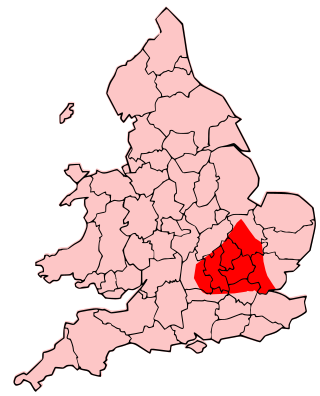
The Catuvellauni were a Celtic tribe or state of southeastern Britain before the Roman conquest, attested by inscriptions into the 4th century.

Beli Mawr was an ancestor figure in Middle Welsh literature and genealogies. He is the father of Cassivellaunus, Arianrhod, Lludd Llaw Eraint, Llefelys, and Afallach. In certain medieval genealogies, he is listed as the son or husband of Anna, cousin of Mary, mother of Jesus. According to the Welsh Triads, Beli and Dôn were the parents of Arianrhod, but the mother of Beli's other children—and the father of Dôn's other children—is not mentioned in the medieval Welsh literature. Several royal lines in medieval Wales traced their ancestry to Beli. The Mabinogi names Penarddun as a daughter of Beli Mawr, but the genealogy is confused; it is possible she was meant to be his sister rather than daughter.
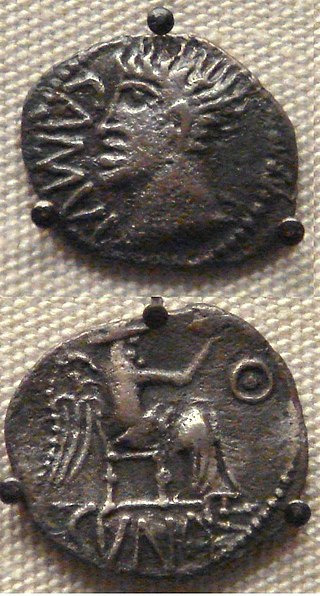
Cunobeline or Cunobelin, also known by his name's Latin form Cunobelinus, was a king in pre-Roman Britain from about AD 9 to about AD 40. He is mentioned in passing by the classical historians Suetonius and Dio Cassius, and many coins bearing his inscription have been found. He controlled a substantial portion of south-eastern Britain, including the territories of the Catuvellauni and the Trinovantes, and is called "King of the Britons" by Suetonius. Cunobeline may have been a client king of Rome, based on the images and legends appearing on his coins. Cunobeline appears in British legend as Cynfelyn (Welsh), Kymbelinus or Cymbeline, as in the play by William Shakespeare.
Togodumnus was king of the British Catuvellauni tribe, whose capital was at St. Albans, at the time of the Roman conquest. He can probably be identified with the legendary British king Guiderius. He is usually thought to have led the fight against the Romans alongside his brother, but to have been killed early in the campaign. However, some authorities now argue that he sided with the Romans and is one and the same person as the client-king Tiberius Claudius Cogidubnus, whose original name may have been Togidubnus or Togodumnus.
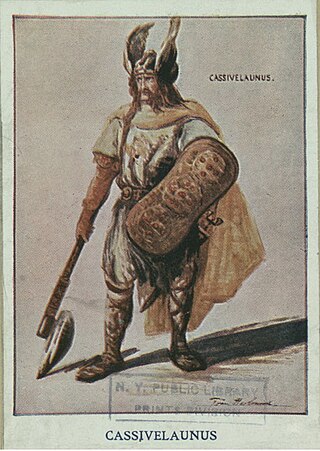
Cassivellaunus was a historical British military leader who led the defence against Julius Caesar's second expedition to Britain in 54 BC. He led an alliance of tribes against Roman forces, but eventually surrendered after his location was revealed to Julius Caesar by defeated Britons.
Catellus was a legendary king of the Britons, as recounted in Geoffrey of Monmouth's work Historia Regum Britanniae. He came to power in 269 BC.
Nennius is a mythical prince of Britain at the time of Julius Caesar's invasions of Britain. His story appears in Geoffrey of Monmouth's History of the Kings of Britain (1136), a work whose contents are now considered largely fictional. In Middle Welsh versions of Geoffrey's Historia he was called Nynniaw.

Historia regum Britanniae, originally called De gestis Britonum, is a pseudohistorical account of British history, written around 1136 by Geoffrey of Monmouth. It chronicles the lives of the kings of the Britons over the course of two thousand years, beginning with the Trojans founding the British nation and continuing until the Anglo-Saxons assumed control of much of Britain around the 7th century. It is one of the central pieces of the Matter of Britain.
Arvirargus or Arviragus was a legendary British king of the 1st century AD, possibly based upon a real person. A shadowy historical Arviragus is known only from a cryptic reference in a satirical poem by Juvenal, in which a giant turbot presented to the Roman emperor Domitian is said to be an omen that "you will capture some king, or Arviragus will fall from his British chariot-pole".
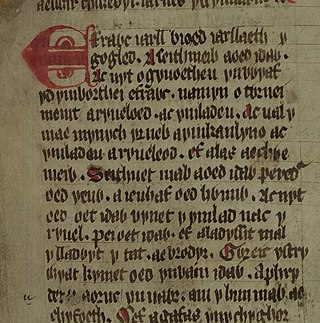
Peredur is the name of a number of men from the boundaries of history and legend in sub-Roman Britain. The Peredur who is most familiar to a modern audience is the character who made his entrance as a knight in the Arthurian world of Middle Welsh prose literature.
Venissa, according to Geoffrey of Monmouth's 12th century Historia Regum Britanniae, was a daughter of the Roman Emperor Claudius, whom he gave in marriage to the British king Arvirargus once he had submitted to Rome.
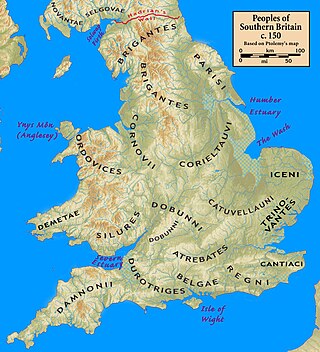
The Roman client kingdoms in Britain were native tribes which chose to align themselves with the Roman Empire because they saw it as the best option for self-preservation or for protection from other hostile tribes. Alternatively, the Romans created some client kingdoms when they felt influence without direct rule was desirable. Client kingdoms were ruled by client kings. In Latin these kings were referred to as rex sociusque et amicus, which translates to "king, ally, and friend". The type of relationships between client kingdoms and Rome was reliant on the individual circumstances in each kingdom.
Guiderius is a legendary British king according to Geoffrey of Monmouth's Historia Regum Britanniae and related texts. He can probably be identified as deriving from the historical Togodumnus.
Catigern is a figure of Welsh tradition, said to be a son of Vortigern, the tyrannical King of the Britons, and the brother of Vortimer. A figure of this name also appears in the Welsh genealogies, though he is given different parentage. Catigern is nearly exclusively known for a tradition in which he fell in battle with the Saxons.
Mandubracius or Mandubratius was a king of the Trinovantes of south-eastern Britain in the 1st century BC.